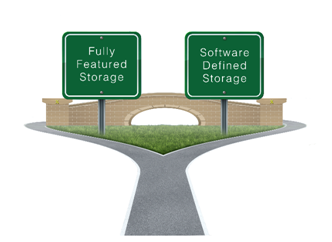infoTECH Feature
Three Truths and a Lie About Adaptive Storage in a Software-defined Future
As it has been for the past three decades, the storage market is going through another one of its cyclical changes, and new vendors are emerging as challengers to the big boys.
According to IDC, sales of high-end storage fell for four consecutive quarters to Q2 2014. IBM, EMC (News ![]() - Alert) and NetApp revenues were all down and HP managed a measly 0.4 percent increase in sales in Q2 2014. At the same time, sales by newer, smaller companies in the storage market increased by 11.1 percent to give them a market share of 21 percent. With the top three legacy storage vendors losing market share to new entrants and smaller, longer-established vendors, end users and resellers now have far more choices when choosing the best tool for the job.
- Alert) and NetApp revenues were all down and HP managed a measly 0.4 percent increase in sales in Q2 2014. At the same time, sales by newer, smaller companies in the storage market increased by 11.1 percent to give them a market share of 21 percent. With the top three legacy storage vendors losing market share to new entrants and smaller, longer-established vendors, end users and resellers now have far more choices when choosing the best tool for the job.
An annoying problem arises when new entrants with loud voices make bold, sometimes ludicrous, claims. Take the line being touted by one of these new(ish) vendors, “Hard disks are dead. The future is all-flash.” At the fear of sounding like a scratched record, this couldn’t be further from the truth.
Flash is a fantastic tool that delivers lower latency, improved I/O rates, and has lowered the cost barrier for many high-performance applications. Will it replace hard disk drives in the short to medium term? No, not at all. It’s like the point being made 10 years ago that tape is dead. Its role might change slightly but the traditional hard disk drive is here to stay for a long time yet.
The lie about disk being dead brings me to my main point: there are three truths about truly adaptive storage that IT managers should understand before starting their next project.
Truth #1: One size doesn’t fit all
What is interesting is how many arrays are being designed for hard disk drives OR for flash. There are some in-between approaches using tricks such as a flash cache to compensate for slow SATA drives, but the vast majority of vendors make customers choose between a slow and a fast platform—a choice that needs to be made up front.
What would be ideal is something more adaptable—that moves from large, practical vehicle into a high-performance speedster, but at a sensible price. You need the right storage technology for the application.
I suppose a good analogy would be the choice you have to make when purchasing a car—do you go for the high-performance two-seater or get the station wagon with four-door functionality and flexibility. It all depends on your priorities—are you after speed or practicalities? Well yes, there’s the Porsche Cayenne but then you’re paying a premium for the blend of performance and convenience. Maybe you don’t need a sports car or even a wagon. Sometimes you need a Winnebago. But your storage must adapt based on what your business needs, not what the vendor is trying to sell that month.
Truth #2: Storage investments should last more than 2-3 years
The second point about storage being adaptive is investment protection. Currently, many applications are best served by storage which is oriented toward features rather than performance and simplicity. However, with the slowly increasing maturity of Software Defined Storage, this core approach is extremely likely to switch. The question stands, should you deploy a feature-rich array today and then buy again in say 12-24 months’ time? Obviously, not many CFOs would support that approach. For many customers and resellers this choice is a concern and they’re at a road junction with no way to cross over to a different road.
Likewise, they could also find themselves in a cycle of technology refreshes every two or three years as dictated by the industry. If their product is truly flexible, reliable and worry free, vendors should guarantee the product will perform consistently for five or more years. This long-lasting service record is the investment protection every CFO would want.
Truth #3: Adaptive storage needs to be truly flexible
This is the other part of “adaptive” that is important – the ability to interchange between both worlds when you’re ready. If you do decided that the feature-rich SAN is the way to go today then it’s wise to look at platforms that can adapt and interchange to SDS when you’re ready.
Far too many vendors are using off-the-shelf commodity hardware these days and putting all of their investment into the software layer only. This means that the underlying hardware is just dumb disk that won’t give users the reliability and performance needed for their software-defined world. The more rational strategy is to invest in a platform that is designed to bridge the two approaches.
After all, being able to fill a round hole with a round peg and a square hole with a square peg is important. Filling a round hole with a square peg by using a hammer isn’t the most efficient approach. IT managers must choose the right tool for the job and protect against technology dead ends. Whether hard disk, hybrid flash, or all flash they should utilize the appropriate media for their workload. They should look for opportunities to deploy networked storage today and adapt to become the hardware foundation for Software Defined Storage in the future.
Then they’ll be able to have a much more pleasant conversation with the aforementioned CFO—something that makes life easier for everyone.

About the Author: Gavin McLaughlin joined X-IO in 2011 and leads all outbound communications at X-IO including press and analyst relations, together with development and articulation of X-IO’s core strategy. Mr. McLaughlin brings over 25 years of technical, sales and marketing experience of the storage industry at organizations such as EMC, HP and Sun Microsystems (News ![]() - Alert). Mr. McLaughlin is also a regular speaker with regards to the use of various storage technologies, implementations and techniques and is based in the United Kingdom. Mr. McLaughlin holds a Master of Business Administration and Business Leadership post-graduate degree from the University of Liverpool.
- Alert). Mr. McLaughlin is also a regular speaker with regards to the use of various storage technologies, implementations and techniques and is based in the United Kingdom. Mr. McLaughlin holds a Master of Business Administration and Business Leadership post-graduate degree from the University of Liverpool.
Edited by Dominick Sorrentino
infoTECH Headlines
What Is AWS EFS? Features, Use Cases, and Critical Best Practices
Cost-Effective Approaches to s1000d Conversion
A virtual crossroads for technology enthusiasts
Benefits of employee monitoring software in preventing overworking of workers
CI/CD: Trends and Predictions for 2024
Technical Documentation for IT: A Practical Guide
Managing Your Costs on AWS: A 2024 Guide
What Is Application Dependency Mapping?
Top 5 Kubernetes Errors and How to Solve Them
How Artificial Intelligence Can Improve the World of Online Gaming Platforms
Rich Tehrani
Rich Tehrani



 By
By 
